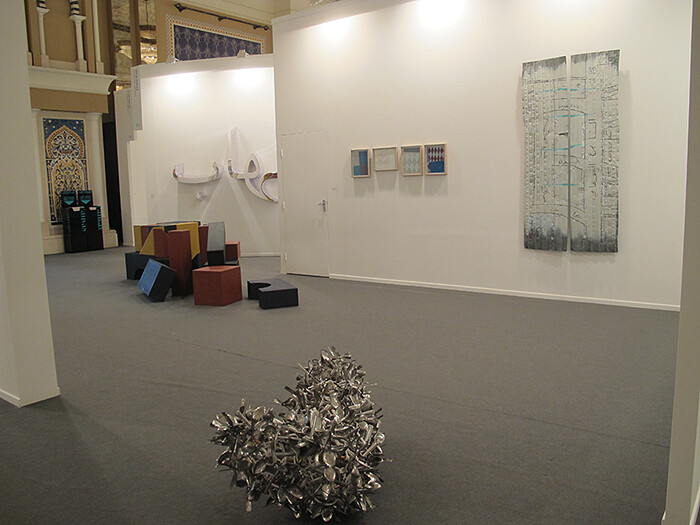March 21–24, 2012
“The Arab Spring is (not quite) Old News”
Old news. That’s how Fred Sicre (of Abraaj Capital, Art Dubai’s partner) dubbed the Arab Spring. The flaming politics of the last year’s events have been reduced to the mere glimmers in the Emirati’s up-and-coming art fair. In the past three years, the fair has evolved significantly, gaining more composure and confidence—it has started trusting artworks. This year a new wave of galleries joined the fair for the first time, and the curated focus section featured a pick of galleries and spaces from Indonesia, selected by Alia Swastika, one of the curators of the upcoming Gwangju Biennial.
Galerie Sfeir Semler (Beirut/Hamburg) presented a number of artists, whose works echoed elsewhere around the fair, including Walid Raad, Yto Barrada, Wael Shawky, and Hassan Sharif. This mini-show on Formalism is off-set nicely with a series of Khalil Rabah’s paintings of exhibition openings, including a rather large oil on canvas of a Damien Hirst opening (Art Exhibition: Damien Hirst, Zott, 2011).
Local artist Hassan Sharif features in another section of the fair with a more extensive presentation of his work coupled to create some poetic parallels with the German-born Uruguayan artist Luis Camnitzer at Alexander Grey Associates. Sharif’s one-minute drawing, from his series of experiments in the early 1980s, turn time into tangible manifestations of marks on paper, while Luis Camnitzer’s works, mostly from the late 60s and 70s, carry a more ethereal quality; his playful puns and language based graphic experiments have pushed the traditions of printmaking. Most poignant are inclusions of works from his series Assignment book (2011). His Assignment #2—a jumble open and folded books, piled, bound and belted with tape on a plinth—suggests to its viewer how to look at art. To its left is Sharif’s sculpture, a pile of coarsely folded enforced cardboard entangled with thin metal wires, a transposed drawing that rests amongst his recent semi-system drawings.
A number of returning galleries avoided the more usual clustered sampling of works in favor of solo shows. Goodman Gallery (South Africa) made a sound, and somewhat safe, choice in presenting William Kentridge. His encrypted socio-political critique of the resurgence of Spring politics via Shostakovich’s “The Nose” was intriguing, a surreal exploration map of totalitarian oppression.
Overall, the questionable absence of overt political work is perhaps due to the Criminal Investigation Department’s keeping a withering eye on the exhibitors just hours before the fair opened to the public. The nuances and particularities of the Emirati art world though are too complex to discern at first sight or seasonal visits. The fair is rife with subtle details that present “real art politic,” and there is more here than just the “trade capital” meets art cliché—and, indeed, the fair is increasingly made up of non-commercial projects. One such project is Magdi Mostafa’s Elements of the Unexpected (2012) from his series “Sound Cells,” produced while on residency at A.i.R., Dubai. The installation of tahana bread dough machines on loan from a factory supplier outside Sharjah, are from—and will be returned to Syria—after the show. The equipment, weighing several tons and exceeding the allocated production budget, are on loan with the artist who “pawned” his passport to be able to borrow this heavy machinery. The site-specific installation, using the two rows of tahana’s dark sticky date honey (recalling oil), miked and connected to an amp, is the artist’s own interpretation of the scent- and sound-scape of the Gulf.
Elsewhere, if you cracked open the fortune cookies of Ubik (a Dubai-based anonymous artist) you would find revelations of the artist’s bank balance, in a work conceived specifically for the fair. Portrait of an artist through his bank statements include 5,000 unique bank statements of the artist’s expenditures between January 2011 and 2012, discreetly placed in cookie bowls throughout the fair. Despite all the additional hype, it’s remarkable how much of this year’s fair incorporates off-site activities, even intently nurturing collaborations with artists, curators, non-profits, and institutions alike, both regionally and internationally. While the Spring is far from over, the fair is growing out of its emerging status, gaining a more carefully considered demeanor as politics and activism—not the bad fine art sort—become part of the system that holds the nascent commerce of art in the region together.







